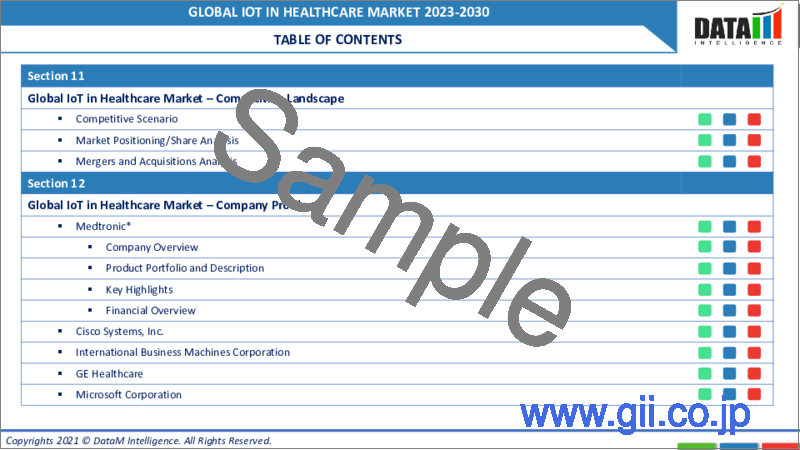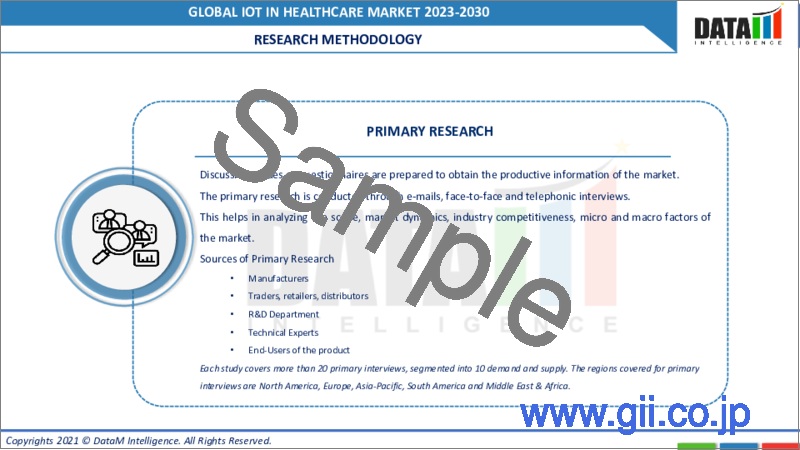|
|
市場調査レポート
商品コード
1297800
ヘルスケアにおけるIoTの世界市場-2023年~2030年Global IoT in Healthcare Market - 2023-2030 |
||||||
カスタマイズ可能
適宜更新あり
|
|||||||
| ヘルスケアにおけるIoTの世界市場-2023年~2030年 |
|
出版日: 2023年06月15日
発行: DataM Intelligence
ページ情報: 英文 195 Pages
納期: 即日から翌営業日
|
- 全表示
- 概要
- 目次
市場概要
ヘルスケアにおけるIoT(モノのインターネット)世界市場は、2022年に1,202億米ドルに達し、2030年には3,902億米ドルに達するなど、有利な成長が予測されています。世界のヘルスケアにおけるIoT市場は、予測期間中(2023年~2030年)に16.4%のCAGRを示すと予測されています。ウェアラブルデバイスの使用の増加、AIとIoTの統合が、ヘルスケアにおけるIoT市場動向の需要を押し上げています。
世界のヘルスケアにおけるIoT市場は、ヘルスケア分野におけるIoT技術の採用拡大により、急速に拡大しています。IoTがヘルスケアに統合されると、シームレスな接続性、リアルタイムのモニタリング、データ駆動型の洞察が提供され、ヘルスケアサービスの提供に革命をもたらします。IoTデバイス、センサー、プラットフォームをヘルスケア・アプリケーションに組み込むことで、患者の転帰を改善し、業務効率を高め、医療費を削減できる可能性があります。
ヘルスケアにおけるIoTの市場範囲は、医療機器、システム&ソフトウェア、サービス、その他を包含するコンポーネントで構成され、ヘルスケアにおけるIoTの市場シェアを拡大させています。ヘルスケアにおけるIoTの世界市場は、遠隔患者モニタリングの需要拡大、技術の進歩、ヘルスケアの効率と質の向上に対するニーズ、高齢化人口の増加などの要因により拡大しています。
市場力学
高齢化人口の増加がヘルスケアにおけるIoT市場の成長を牽引
高齢化人口の増加は、ヘルスケアにおけるIoT市場の主要な促進要因になると予想されます。高齢化が進む中、高齢者特有のニーズに対応できる革新的なヘルスケアソリューションに対する需要は高いです。例えば、世界保健機関(WHO)の2022年報告書によると、2030年までに地球上の約6人に1人が60歳以上になります。この期間内に、60歳以上の世界人口に占める割合は、2020年の10億人から14億人に増加すると予想されています。
IoT技術は、さまざまなアプリケーションを通じて、この層のケアの質を向上させることができます。遠隔監視デバイス、ウェアラブルセンサー、スマートホームシステムにより、継続的な健康監視、転倒検知、服薬管理、遠隔診察が可能になります。ヘルスケア施設の負担を軽減する一方で、こうしたIoTソリューションにより、高齢者はその場で年を重ね、個別ケアを受け、自立を維持することができます。したがって、高齢化人口の増加がヘルスケアにおけるIoT市場を牽引しています。
スマートフォンの普及が世界のヘルスケアIoT市場の主要促進要因
世界人口の大半がスマートフォンを所有しているため、IoT対応ヘルスケアソリューションが広く利用可能になっています。ヘルスケアにおける様々なIoTデバイスやアプリケーションは、スマートフォンからアクセスでき、相互作用が可能です。例えば、Mobile Economy 2022レポートによると、スマートフォンの普及率は2021年に世界人口の67%に達し、2025年には85%に達すると予想されています。このようにスマートフォンが普及した結果、ヘルスケアにおけるIoTソリューションが採用される可能性が高まっています。
スマートフォンによって、ヘルスケアにおけるさまざまなIoTデバイスやアプリケーションにアクセスし、相互作用することができます。遠隔モニタリングやシームレスな接続がこの技術によって可能になり、ヘルスケアサービスの提供が強化されます。スマートフォンの普及は、ヘルスケア分野におけるIoT技術の拡大と受容に貢献し、最終的に市場の成長を促進します。
サイバーセキュリティへの懸念が市場の成長を妨げる
医療機器に関連するサイバーセキュリティの脆弱性は、複数の要因から生じる複雑な問題であり、慎重な検討が必要です。孤立した機器から相互接続されたネットワークへの移行は、セキュリティと安全性のバランスを取る上で課題をもたらします。さまざまな事件は、この領域におけるサイバーセキュリティの懸念が広範囲に及ぶことを示す例となっています。
しかし、デバイス自体にセキュリティ制御が組み込まれていないことは、結果として発生する特定のインシデントよりも重大な懸念事項であることに注意することが重要です。調査によると、セキュリティ対策が不十分なウェブ・インターフェイス、ハードコードされた管理パスワード、インターネットにアクセスできる内部ネットワークに接続されたデバイスなど、一般的な脆弱性が指摘されています。したがって、これらの上記の要因がヘルスケアにおけるIoT市場の成長を制限しています。
COVID-19影響分析
COVID-19のパンデミックと世界各国でのロックダウンにより、あらゆる業種の企業の財務の健全性が影響を受けています。そのため、COVID-19公衆衛生緊急事態の期間中、米国食品医薬品局(FDA)は、スポンサーと研究者を支援し、試験参加者の安全を確保し、適正臨床実施基準(GCP)を遵守し、試験の完全性に対するリスクを最小限に抑えるための一般的な配慮を含むガイドラインを発表しました。
ロシア・ウクライナ紛争の影響分析
ロシア・ウクライナ紛争は、ヘルスケアにおけるIoTに大きな影響を与えています。病院や診療所を含むヘルスケア・インフラへの被害は、IoTデバイスの展開と運用を損なう。紛争地域での停電や接続性の悪さは、安定した電力とインターネットアクセスに依存するIoT機器の有用性を低下させる。
ヘルスケア従事者と患者の移動は、ケアの継続性とヘルスケアサービスへのアクセスを妨げ、IoTデバイスの使用を阻害します。戦争中はサイバーセキュリティの懸念が高まり、医療データとIoTネットワークに危険が及ぶ。貿易の混乱はIoTデバイスの可用性を低下させ、ヘルスケアでの利用を制限します。このような障害にもかかわらず、安定を回復し、セキュリティ手順を改善する努力は、ヘルスケアにおけるIoTへの紛争の影響を軽減するのに役立つ。
目次
第1章 調査手法と調査範囲
第2章 定義と概要
第3章 エグゼクティブサマリー
第4章 市場力学
- 影響要因
- 促進要因
- 高齢化人口の増加
- スマートフォンの普及
- 抑制要因
- サイバーセキュリティへの懸念
- 機会
- 影響分析
- 促進要因
第5章 産業分析
- ポーターの5フォース分析
- サプライチェーン分析
- 価格分析
- 規制分析
第6章 COVID-19分析
第7章 コンポーネント別
- 医療機器
- システム・ソフトウェア
- サービス
- コネクティビティ技術
第8章 用途別
- 遠隔医療
- 臨床業務およびワークフロー管理
- コネクテッドイメージング
- 入院患者モニタリング
- 投薬管理
- その他
第9章 エンドユーザー別
- 病院および診療所
- 臨床研究機関
- 研究・診断機関
- その他
第10章 地域別
- 北米
- 米国
- カナダ
- メキシコ
- 欧州
- ドイツ
- 英国
- フランス
- スペイン
- イタリア
- その他欧州
- 南米
- ブラジル
- アルゼンチン
- その他南米
- アジア太平洋
- 中国
- インド
- 日本
- その他アジア太平洋地域
- 中東およびアフリカ
- 主な地域別ダイナミクス
第11章 競合情勢
- 競合シナリオ
- 市況/シェア分析
- M&A分析
第12章 企業プロファイル
- Medtronic
- 会社概要
- 製品ポートフォリオと説明
- 財務概要
- 主な発展
- Cisco Systems, Inc.
- IBM Corporation
- GE Healthcare
- Microsoft Corporation
- SAP SE
- Infosys Limited
- Cerner Corporation
- QUALCOMM Incorporated
- Wipro ltd
第13章 付録
Market Overview
The Global IoT (Internet of Things) In Healthcare Market reached US$ 120.2 billion in 2022 and is projected to witness lucrative growth by reaching up to US$ 390.2 billion by 2030. The global IoT in healthcare market is expected to exhibit a CAGR of 16.4% during the forecast period (2023-2030). The increasing use of wearable devices, and integration of AI and IoT are driving up demand for IoT in healthcare market trends.
The global IoT in the healthcare market is expanding rapidly, owing to the growing adoption of IoT technologies in the healthcare sector. When IoT is integrated with healthcare, it offers seamless connectivity, real-time monitoring, and data-driven insights, revolutionizing the delivery of healthcare services. The incorporation of IoT devices, sensors, and platforms into healthcare applications has the potential to improve patient outcomes, boost operational efficiency, and lower healthcare costs.
The IoT in the healthcare market scope comprises components encompassing medical devices, system & software, services, and others, which has increased usage of IoT in healthcare market share. The global market for IoT in healthcare is expanding as a result of factors including the growing demand for remote patient monitoring, technological advancements, need for improved healthcare efficiency and quality, and rising aging population market growth.
Market Dynamics
An Increase in Aging Population Drive the Growth of the IoT in Healthcare Market
The growing aging population is expected to be a major driver for IoT in healthcare market. As the population continues to age, there is high demand for innovative healthcare solutions that can cater to the specific needs of older adults. For instance, according to World Health Organization (WHO) 2022 report, by 2030, about one out of every six people on the planet will be 60 or older. Within this time span, the share of the world population aged 60 and up is expected to increase from 1 billion in 2020 to 1.4 billion.
IoT technologies can improve the quality of care for this demographic through a range of applications. Remote monitoring devices, wearable sensors, and smart home systems enable continuous health monitoring, fall detection, medication management, and remote consultations. While reducing the burden on healthcare facilities, these IoT solutions enable older adults to age in place, receive personalized care, and maintain independence. Hence, the growing aging population is driving the IoT in healthcare market.
Higher Penetration of Smart Phones is the Major Driver in the Global IoT in Healthcare Market
The majority of the global population owns smartphones, which makes IoT-enabled healthcare solutions widely available. Various IoT devices and applications in healthcare are accessible and interactable through smartphones. For instance, according to the Mobile Economy 2022 report, smartphone penetration reached 67% of the global population in 2021 and is expected to reach 85% by 2025. IoT solutions in healthcare are more likely to be adopted as a result of this widespread adoption of smartphones.
Smartphones allow individuals to access and interact with various IoT devices and applications in healthcare. Remote monitoring and seamless connectivity are enabled by this technology, enhancing the delivery of healthcare services. The increasing adoption of smartphones contributes to the expansion and acceptance of IoT technologies in the healthcare sector, ultimately driving market growth.
Cybersecurity Concerns will Hamper the Growth of the Market
The cybersecurity vulnerability associated with medical devices is a complex issue that arises from multiple factors and requires careful consideration. The shift from isolated devices to interconnected networks introduces challenges in balancing security and safety. Various incidents serve as examples of the wide-ranging cybersecurity concerns in this domain.
However, it is important to note that the absence of embedded security controls in the devices themselves is a more significant concern than the specific incidents that occur as a result. Research indicates common vulnerabilities such as web interfaces with inadequate security measures, hardcoded administration passwords, and devices connected to internal networks with internet access. Hence these above mentioned factors are limiting the IoT in healthcare market's growth.
COVID-19 Impact Analysis
The financial health of companies across all industries has been impacted by the COVID-19 pandemic and lockdown in numerous nations throughout the world. Therefore, for the period of the COVID-19 public health emergency, the U.S. Food and Drug Administration (FDA) issued guidelines that include general considerations to aid sponsors and researchers, ensuring the safety of trial participants, adhering to good clinical practice (GCP), and minimizing risks to trial integrity.
Russia-Ukraine War Impact Analysis
The Russia-Ukraine conflict has had a huge impact on IoT in healthcare. Damage to healthcare infrastructure, including hospitals and clinics, impairs the deployment and operation of IoT devices. Power interruptions and poor connectivity in conflict zones reduce the usefulness of IoT devices that rely on consistent power and internet access.
Displacement of healthcare workers and patients hinders continuity of care and access to healthcare services, impeding the use of IoT devices. During a war, cybersecurity concerns increase, posing hazards to medical data and IoT networks. Trade disruptions reduce the availability of IoT devices, limiting their use in healthcare. Despite these hurdles, efforts to restore stability and improve security procedures can help lessen the impact of the conflict on IoT in healthcare.
Segment Analysis
The global IoT in healthcare market is segmented based on component, application, end user and region.
Wearable External Medical Devices Segment Accounts for 34.3% of the Market Share Owing to Rising Demand
The wearable external medical devices segment is expected to dominate the global IoT in healthcare market due to the increasing demand for wearable devices that can track and monitor health data in real time. Wearable devices such as smartwatches, fitness trackers, and biosensors enable continuous monitoring of physiological parameters, activity levels, and sleep patterns.
External medical devices, including remote patient monitoring systems, smart inhalers, and insulin pumps, offer advanced healthcare monitoring and management outside of traditional healthcare settings. In addition, the increasing prevalence of chronic diseases such as diabetes, heart disease, and cancer is also driving the demand for wearable external medical devices. These devices can be used to monitor patients' health data and provide alerts if there are any changes in their condition. This can help to improve patient outcomes and reduce the risk of complications.
Hospitals are increasingly embracing wearable medical devices to enhance patient compliance and care. For instance, Manipal Hospitals uses a remote monitoring system connected to Fitbit gadgets to monitor patients' post-surgery rehabilitation. A ConnectedLife online monitoring solution is used to record and transmit patient data, such as heart rate and sleep quality, to healthcare experts.
A sophisticated AI-powered in-patient room automation system that Apollo Hospitals has introduced enables remote monitoring of respiratory and cardiac rates. For convenient health screening and diagnosis, they have also implemented IoT-enabled smart health kiosks. The delivery of healthcare is being revolutionized by these developments, which are also advancing accessibility.
Geographical Analysis
North America Accounted for Approximately 41.4% of the Market Share Owing to the Investment by the Major Players' Presence in this Region
North America's market dominance has been facilitated by the presence of established and influential companies such as technological behemoths, along with innovative startup presence, healthcare providers, and IoT solution suppliers. These organizations have recognized the potential of IoT to improve healthcare delivery and have made significant investments in developing and deploying IoT solutions in the healthcare industry. Their investment initiatives have expedited the adoption of IoT technologies and the market's growth in North America.
For instance, in December 2022, Spike, an American company that specializes in API aggregation and ETL solutions for wearable and IoT device data, has completed a $700,000 pre-seed investment round. The funding is intended to assist digital health enterprises in improving the well-being of their clients. Spike provides an easy-to-use integration platform that allows businesses to combine biomarker data from over 200 wearable sensors and IoT devices into their applications.
This data includes crucial information such as HRV, glucose and cortisol levels, calories, sleep depth, blood pressure, and more. By using Spike's technology, digital health organisations may gain access to and successfully use a wide range of biometric data to better the lives of their clients.. Therefore, these factors show the dominance of North America region in this market.
Competitive Landscape
The major global players in the IoT in healthcare market include: Medtronic, Cisco Systems, Inc., IBM Corporation, GE Healthcare, Microsoft Corporation, SAP SE, Infosys Limited, Cerner Corporation, QUALCOMM Incorporated, and Wipro ltd among others.
Why Purchase the Report?
- To visualize the global IoT in healthcare market segmentation based on component, application, end user and region, as well as understand key commercial assets and players.
- Identify commercial opportunities by analyzing trends and co-development.
- Excel data sheet with numerous data points of IoT in healthcare market-level with all segments.
- PDF report consists of a comprehensive analysis after exhaustive qualitative interviews and an in-depth study.
- Product mapping available as Excel consisting of key products of all the major players.
The global IoT in healthcare market report would provide approximately 53 tables, 54 figures and 195 Pages.
Target Audience 2023
- Manufacturers/ Buyers
- Industry Investors/Investment Bankers
- Research Professionals
- Emerging Companies
Table of Contents
1. Methodology and Scope
- 1.1. Research Methodology
- 1.2. Research Objective and Scope of the Report
2. Definition and Overview
3. Executive Summary
- 3.1. Snippet by Component
- 3.2. Snippet by Application
- 3.3. Snippet by End User
- 3.4. Snippet by Region
4. Dynamics
- 4.1. Impacting Factors
- 4.1.1. Drivers
- 4.1.1.1. An Increase in Aging Population
- 4.1.1.2. Higher Penetration of Smart Phones
- 4.1.2. Restraints
- 4.1.2.1. Cybersecurity Concerns
- 4.1.3. Opportunity
- 4.1.4. Impact Analysis
- 4.1.1. Drivers
5. Industry Analysis
- 5.1. Porter's 5 Forces Analysis
- 5.2. Supply Chain Analysis
- 5.3. Pricing Analysis
- 5.4. Regulatory Analysis
6. COVID-19 Analysis
- 6.1. Analysis of COVID-19
- 6.1.1. Scenario Before COVID-19
- 6.1.2. Scenario During COVID-19
- 6.1.3. Scenario Post COVID-19
- 6.2. Pricing Dynamics Amid COVID-19
- 6.3. Demand-Supply Spectrum
- 6.4. Government Initiatives Related to the Market During Pandemic
- 6.5. Manufacturers Strategic Initiatives
- 6.6. Conclusion
7. By Component
- 7.1. Introduction
- 7.1.1. Market Size Analysis and Y-o-Y Growth Analysis (%), By Component
- 7.1.2. Market Attractiveness Index, By Component
- 7.2. Medical Devices*
- 7.2.1. Introduction
- 7.2.2. Market Size Analysis and Y-o-Y Growth Analysis (%)
- 7.3. System & Software
- 7.4. Services
- 7.5. Connectivity Technology
8. By Application
- 8.1. Introduction
- 8.1.1. Market Size Analysis and Y-o-Y Growth Analysis (%), By Application
- 8.1.2. Market Attractiveness Index, By Application
- 8.2. Telemedicine*
- 8.2.1. Introduction
- 8.2.2. Market Size Analysis and Y-o-Y Growth Analysis (%)
- 8.3. Clinical Operations and Workflow Management
- 8.4. Connected Imaging
- 8.5. Inpatient Monitoring
- 8.6. Medication Management
- 8.7. Others
9. By End User
- 9.1. Introduction
- 9.1.1. Market Size Analysis and Y-o-Y Growth Analysis (%), By End User
- 9.1.2. Market Attractiveness Index, By End User
- 9.2. Hospitals and Clinics*
- 9.2.1. Introduction
- 9.2.2. Market Size Analysis and Y-o-Y Growth Analysis (%)
- 9.3. Clinical Research Organizations
- 9.4. Research and Diagnostic Laboratories
- 9.5. Others
10. By Region
- 10.1. Introduction
- 10.1.1. Market Size Analysis and Y-o-Y Growth Analysis (%), By Region
- 10.1.2. Market Attractiveness Index, By Region
- 10.2. North America
- 10.2.1. Introduction
- 10.2.2. Key Region-Specific Dynamics
- 10.2.3. Market Size Analysis and Y-o-Y Growth Analysis (%), By Component
- 10.2.4. Market Size Analysis and Y-o-Y Growth Analysis (%), By Application
- 10.2.5. Market Size Analysis and Y-o-Y Growth Analysis (%), By End User
- 10.2.6. Market Size Analysis and Y-o-Y Growth Analysis (%), By Country
- 10.2.6.1. The U.S.
- 10.2.6.2. Canada
- 10.2.6.3. Mexico
- 10.3. Europe
- 10.3.1. Introduction
- 10.3.2. Key Region-Specific Dynamics
- 10.3.3. Market Size Analysis and Y-o-Y Growth Analysis (%), By Component
- 10.3.4. Market Size Analysis and Y-o-Y Growth Analysis (%), By Application
- 10.3.5. Market Size Analysis and Y-o-Y Growth Analysis (%), By End User
- 10.3.6. Market Size Analysis and Y-o-Y Growth Analysis (%), By Country
- 10.3.6.1. Germany
- 10.3.6.2. The U.K.
- 10.3.6.3. France
- 10.3.6.4. Spain
- 10.3.6.5. Italy
- 10.3.6.6. Rest of Europe
- 10.4. South America
- 10.4.1. Introduction
- 10.4.2. Key Region-Specific Dynamics
- 10.4.3. Market Size Analysis and Y-o-Y Growth Analysis (%), By Component
- 10.4.4. Market Size Analysis and Y-o-Y Growth Analysis (%), By Application
- 10.4.5. Market Size Analysis and Y-o-Y Growth Analysis (%), By End User
- 10.4.6. Market Size Analysis and Y-o-Y Growth Analysis (%), By Country
- 10.4.6.1. Brazil
- 10.4.6.2. Argentina
- 10.4.6.3. Rest of South America
- 10.5. Asia-Pacific
- 10.5.1. Introduction
- 10.5.2. Key Region-Specific Dynamics
- 10.5.3. Market Size Analysis and Y-o-Y Growth Analysis (%), By Component
- 10.5.4. Market Size Analysis and Y-o-Y Growth Analysis (%), By Application
- 10.5.5. Market Size Analysis and Y-o-Y Growth Analysis (%), By End User
- 10.5.6. Market Size Analysis and Y-o-Y Growth Analysis (%), By Country
- 10.5.6.1. China
- 10.5.6.2. India
- 10.5.6.3. Japan
Australia
- 10.5.6.4. Rest of Asia-Pacific
- 10.6. Middle East and Africa
- 10.6.1. Introduction
- 10.6.2. Key Region-Specific Dynamics
- 10.6.3. Market Size Analysis and Y-o-Y Growth Analysis (%), By Component
- 10.6.4. Market Size Analysis and Y-o-Y Growth Analysis (%), By Application
- 10.6.5. Market Size Analysis and Y-o-Y Growth Analysis (%), By End User
11. Competitive Landscape
- 11.1. Competitive Scenario
- 11.2. Market Positioning/Share Analysis
- 11.3. Mergers and Acquisitions Analysis
12. Company Profiles
- 12.1. Medtronic *
- 12.1.1. Company Overview
- 12.1.2. Product Portfolio and Description
- 12.1.3. Financial Overview
- 12.1.4. Key Developments
- 12.2. Cisco Systems, Inc.
- 12.3. IBM Corporation
- 12.4. GE Healthcare
- 12.5. Microsoft Corporation
- 12.6. SAP SE
- 12.7. Infosys Limited
- 12.8. Cerner Corporation
- 12.9. QUALCOMM Incorporated
- 12.10. Wipro ltd
LIST NOT EXHAUSTIVE
13. Appendix
- 13.1. About Us and Services
- 13.2. Contact Us





